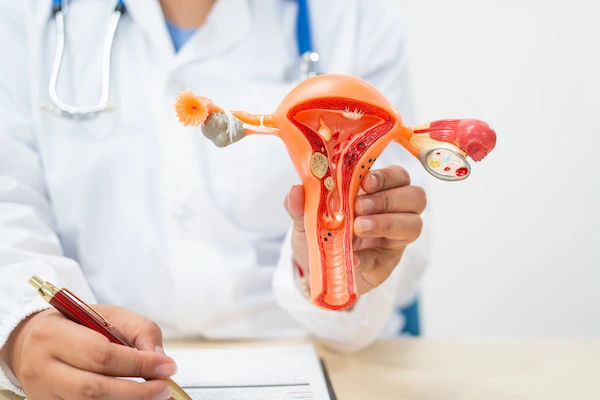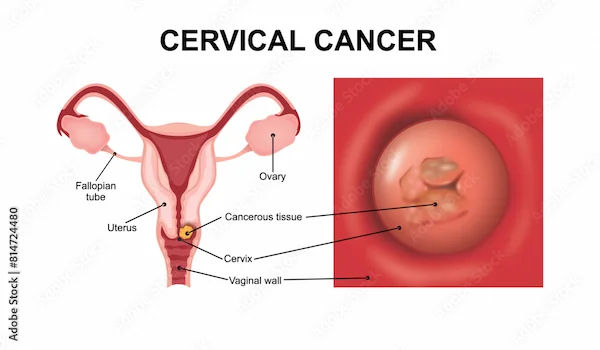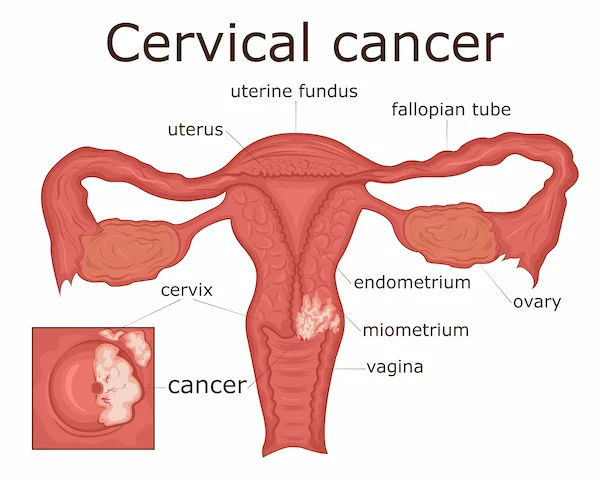Early Signs Of Cervical Cancer: Symptoms, Diagnosis And Treatment For Cervical Cancer
Cervical cancer is preventable and curable. Know the symptoms, risk factors, and early detection methods. Learn how regular screening and awareness can save lives.

Written by Dr Sonia Bhatt
Last updated on 3rd Jul, 2025
Cervical cancer remains one of the most preventable but worrisome gynaecological cancers in women today. Since it is a slow-growing type of cancer, this disease may not show symptoms in the initial stage, and screening is necessary. If diagnosed at an early stage, it has a 93% survival rate, which is why knowing the early signs can be lifesaving.
This blog covers the common signs, modern diagnostic techniques, effective preventive strategies, and various treatment options.
Understanding Cervical Cancer
The primary risk factor of cervical cancer is the persistent infection with high-risk subtypes of HPV (Human papillomavirus), which is prevalent globally. Key risk factors include:
Multiple sexual partners
Having a weak immune system
Long-term use of contraceptives
Multiple pregnancies
Smoking
Pathophysiology of Cervical Cancer
The biological transition from HPV infection to cervical cancer is a well-recognized pattern. High-risk HPV strains may reside on cervical cells, and if the cells do not clear them completely, they can incorporate themselves into the host genome. This produces two viral proteins, E6 and E7, that inactivate normal cell cycle regulatory proteins p53 and pRb, respectively.
These cellular changes cause uncontrolled cell growth and the build-up of genetic mutations that turn borderline cervical cells into precancerous ones and, if left untreated, cancerous cells.
Early Symptoms of Cervical Cancer
Cervical cancer is asymptomatic in the early stages. Here's a detailed look at the key symptoms:
Unusual Vaginal Bleeding
The first noticeable sign is bleeding after intercourse, intramenstrual bleeding or bleeding after menopause.
Pelvic Pain and Discomfort
Chronic pelvic pain may also signify cervical cancer. This may include pain experienced during intercourse, that is, dyspareunia, persistent lower back ache, dull pain in the pelvis, or pressure-like pain in this region felt occasionally.
Irregular Menstrual Cycles
A common sign is heavier periods than usual, irregular brown spotting between periods or unexpected bleeding.
Unexplained Weight Loss
In the systemic complications, patients may develop other symptoms such as loss of appetite, weight loss and fatigue.
Diagnostic Procedures
Pap smears, used in cervical cancer screening, efficiently identify cell changes several years before cancer cells can form.
During this process, cells are scraped off the cervix, and these samples are subsequently scrutinised under a microscope to check for signs of precancer or cancer
It is a rapid process that does not require much sample collection and is almost perfect for early detection of possible complications
The current screening guidelines are at age 21 and based on an individual’s age and risk factors
HPV Testing
HPV testing compliments rather than replaces Pap smears to give a better view of the cervical situation.
This molecular test has been designed to detect the presence of high-risk HPV strains that are responsible for cervical cancer
In the event of an abnormal Pap result, HPV testing is used to identify high-risk infection that leads to further diagnostic procedures.
Pap and HPV testing (co-testing) has been proven more effective than conventional Pap testing, and its effectiveness is higher among women over 30
Populations at Higher Risk
Cervical cancer still constitutes a significant public health problem characterised by different age distribution and higher risk in certain population groups.
The diagnosis is at an average age of 50, with the most prevalence in the age range of 35-44 years. Although it is comparatively low in women below 20 years of age, the risk persists throughout life, and many postmenopausal women are prone to underestimate their risk. HIV positivity and parity are major demographic indicators of risk that significantly predispose a woman to cervical cancer.
Women with multiple pregnancies of at least four or more have an increased risk of developing cervical cancer
HIV-infected women have a 6 times increased risk than other women
Risk remains high with age, ranging to 20% in women over 65
Prevention Strategies
Vaccination against HPV is an example of primary prevention of cervical cancer. It starts during early adolescence. The HPV vaccination recommended by the CDC (Centers for Disease Control and Prevention) can begin at 9 years of age and should be completed by 26. Dosing varies by age:
Under 15: Two doses, 6-12 months apart
15 and older: Three doses over six months
Immunocompromised: Depending on doctors’ recommendations, taking two or three doses may be necessary
Key preventive lifestyle changes include:
Consuming a balanced diet with lots of fruits, vegetables and whole grain products
Moderate exercise (150 minutes per week) or intense exercise (75 minutes/week)
Keeping BMI between 18.5-24.9
Safe sex and limited number of partners
Treatment Options for Early-stage Cervical Cancer
The first stage of cervical cancer treatment will, therefore, depend on your childbearing plan in the future.
For those desiring to be able to bear a child, doctors can surgically remove a part of the affected tissue (cone biopsy) or even the cervix but spare the uterus (trachelectomy)
For women who do not wish to have children anymore, doctors may have to permanently take out the entire uterus (a hysterectomy)
Radiation therapy is a therapeutic modality that applies high-energy rays to kill cancer cells. It may be used throughout the process as an initial treatment or to remove residual tumour cells afterwards
Chemotherapy involves using chemical substances carried in the blood to treat cancer in the affected parts of the body. These treatments may be used separately or in conjunction depending on the cancer stage and other patient characteristics
Consult Top Gynaecological oncologists For Cervical Cancer Treatment
Prognosis and Survival Rates
Detecting cervical cancer at an early stage improves its prognosis.
If the patient is diagnosed at the earliest stage, the five-year relative survival rate is 91%
The five-year survival rate for stage one diagnoses is about 95%, while stage two retains 70% of the survival rate
The survival rate for a diagnosis in Stage 3 is only 40%, stressing the need for frequent screening and early detection
The survival rate depends on the stage of cancer detection, with localised cancer providing better results when compared to invasive cancer, which has affected other tissues or lymph nodes (60%).
Preventative measures such as HPV vaccination and early cervical cancer screening services have made an equal impact on the reduction in cases of cervical cancer, thus boosting the quality of life of women in the general population.
Conclusion
The prevention, diagnosis, and treatment of cervical cancer have improved by new approaches, screening techniques, and viable treatments. Across the stage, patients' survival rates differ, but early diagnosis helps enhance the results significantly. Through vaccination campaigns, cervical cancer checks, and the availability of support services, cervical cancer can be eradicated steadily, and the affected receive a new lease on life.
Consult Top Gynaecological oncologists For Cervical Cancer Treatment

Dr. Sreeparna Roy
Obstetrician and Gynaecologist
8 Years • MBBS , MS (OBSTETRICS & GYNAECOLOGY), Fellowship in Infertility, Endoscopy & Ultrasonography), Fellowship in Laparoscopy & Hysteroscopy,DRM
Kolkata
Dr Utsa Basu Clinic, Kolkata

Dr. Sai Lakshmi Daayana
Gynaecological Oncologist
18 Years • MBBS, MRCOG
Hyderabad
Apollo Hospitals Jubilee Hills, Hyderabad
(225+ Patients)

Dr. Rupam Manna
Radiation Specialist Oncologist
4 Years • MBBS MD(RADIO THERAPY)
Barasat
Diab-Eat-Ease, Barasat

Dr. Revathi S Rajan
Obstetrician and Gynaecologist
24 Years • MBBS, DGO, DNB.FFMM
Bengaluru
Apollo Clinic, JP nagar, Bengaluru
Dr. Navin Srinivasan
Gynaecological Oncologist
9 Years • MBBS, MS DNB(OBS-GYNAE), MCH (GYNAE ONCOLOGY)
Bengaluru
Apollo Clinic Mahadevapura, Bengaluru


.webp)

